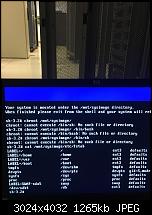|
|
Sponsored Content
Operating Systems
Linux
Red Hat
Chroot: cannot execute /bin/sh: No such file or directory
Post 302995372 by justbow on Wednesday 5th of April 2017 06:08:48 AM
|
|
10 More Discussions You Might Find Interesting
1. UNIX for Dummies Questions & Answers
I just set up an ftp server with Red Hat 5.2. I am doing the work, I'm baby stepping, but it seems like every step I get stuck. Currently, I'm trying to set up a crontab job, but I'm getting the following message: /bin/sh: /usr/bin/vi: No such file or directory. I see that vi exists in /bin/vi,... (3 Replies)
Discussion started by: kwalter
3 Replies
2. UNIX for Advanced & Expert Users
I want to add a default path /bin/mycommands along with others to be loaded as default path for all new accounts created on my system . With out the new accounts not having to change thie manually to /bin/mycommands.Do I change the /etc/profile ? is there any better way?
Please throw some... (2 Replies)
Discussion started by: sravusa
2 Replies
3. UNIX for Advanced & Expert Users
hi i have some perl scripts with shebang line as (#! /usr/bin/env perl ) instead of actual absolute path of perl ( i know why its that way ) everything works fine from command line , the problem is when i am trying to run those scripts from web ( local web tool ) it throws error as /usr/bin/env :... (6 Replies)
Discussion started by: zedex
6 Replies
4. Shell Programming and Scripting
How to code shell script to know if the file in a dirctory is empty i.e., zero byte then not to execute any graph.Please help on this thanks in advance.
---------- Post updated at 08:18 AM ---------- Previous update was at 08:14 AM ----------
I know if clause wil help.my question is how to... (7 Replies)
Discussion started by: vamsi86
7 Replies
5. UNIX for Dummies Questions & Answers
The way this works from the command prompt is:
___________________________________________
cd /data/local/bin
chmod 0755 file.bin
./file.bin
_______________________________________________
How do I make this happen in a script. The file must be run in its directory but I can not get the... (2 Replies)
Discussion started by: chrstdvd
2 Replies
6. AIX
Good day. I currently have a request to have sftp access to a specific directory for a user(s). They can have access to that folder only, and nothing below it.
Now here is the gotcha that seems to be catching me. The folder they need access to is NOT owned by root, and most of the parent... (0 Replies)
Discussion started by: smurphy_it
0 Replies
7. Shell Programming and Scripting
Hello,
When i run a bash script on ubuntu i get this message..
#!/bin/bash cannot find file or directory...
Can anibody help me with this, because the file actually exists....
Is there any extra configuration to be made? (5 Replies)
Discussion started by: oliveiraum
5 Replies
8. Solaris
Hi,
I am getting below error in Solaris 10 SPARC when trying to issue a search on /var/tmp partition
Below is the query
/bin/find /var/tmp/ -type f -atime +1
Below is the result
/bin/find: stat() error <File> : No such file or directory (28 Replies)
Discussion started by: prash358
28 Replies
9. Shell Programming and Scripting
I keep getting this error and I am not sure why.
-bash: ./p4: /bin/ksh^M: bad interpreter: No such file or directory
First I run my makefile and this works fine:
goodmain: main.o
gcc -o goodmain main.o
main.o: main.c
gcc -c main.c
Then I want to limit my output so I... (11 Replies)
Discussion started by: cokedude
11 Replies
10. Shell Programming and Scripting
Hi,
I installed ruby using rvm with root user on Linux.
Now i m trying the below command as a non root user with sudo privileges.
sudo /usr/local/rvm/rubies/ruby-2.2.5/bin/gem install passenger
I get the below error:
I had even reset the path for both gem as well as ruby as you... (8 Replies)
Discussion started by: mohtashims
8 Replies
LEARN ABOUT SUNOS
installgrub
installgrub(1M) installgrub(1M) NAME
installgrub - install GRUB in a disk partition or a floppy SYNOPSIS
/sbin/installgrub [-fm] stage1 stage2 raw-device The installgrub command is an -only program. GRUB stands for GRand Unified Bootloader. installgrub installs GRUB stage 1 and stage 2 files on the boot area of a disk partition. If you specify the -m option, installgrub installs the stage 1 file on the master boot sector of the disk. The installgrub command accepts the following options: -f Suppresses interaction when overwriting the master boot sector. -m Installs GRUB stage1 on the master boot sector interactively. The installgrub command accepts the following operands: stage1 The name of the GRUB stage 1 file. stage2 The name of the GRUB stage 2 file. raw-device The name of the device onto which GRUB code is to be installed. It must be a character device that is readable and writable. For disk devices, specify the slice where the GRUB menu file is located. (For Solaris it is the root slice.) For a floppy disk, it is /dev/rdiskette. Example 1: Installing GRUB on a Hard Disk Slice The following command installs GRUB on a system where the root slice is c0d0s0: example# /sbin/installgrub /boot/grub/stage1 /boot/grub/stage2 /dev/rdsk/c0d0s0 Example 2: Installing GRUB on a Floppy The following command installs GRUB on a formatted floppy: example# mount -F pcfs /dev/diskette /mnt # mkdir -p /mnt/boot/grub # cp /boot/grub/* /mnt/boot/grub # umount /mnt # cd /boot/grub # /sbin/installgrub stage1 stage2 /dev/rdiskette /boot/grub Directory where GRUB files reside. See attributes(5) for descriptions of the following attributes: +-----------------------------+-----------------------------+ | ATTRIBUTE TYPE | ATTRIBUTE VALUE | +-----------------------------+-----------------------------+ |Availability |SUNWcsu | +-----------------------------+-----------------------------+ |Interface Stability |Evolving | +-----------------------------+-----------------------------+ boot(1M), fdisk(1M), fmthard(1M), kernel(1M), attributes(5) Installing GRUB on the master boot sector (-m option) overrides any boot manager currently installed on the machine. The system will always boot the GRUB in the Solaris partition regardless of which fdisk partition is active. 24 May 2005 installgrub(1M)
